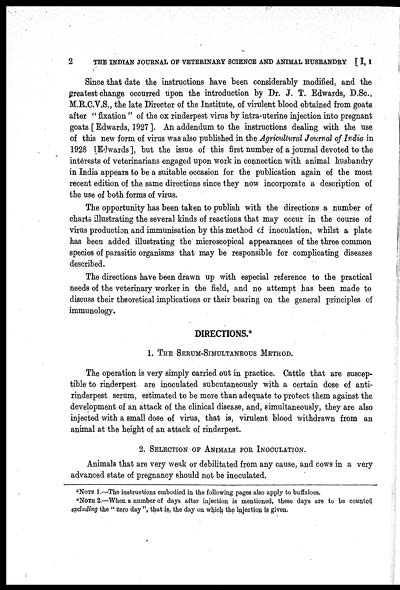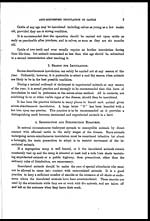Medicine - Veterinary > Veterinary colleges and laboratories > Indian journal of veterinary science and animal husbandry > Volume 1, 1931 > Part I (March 1931) > Directions for the serum-simultaneous anti-rinderpest inoculation of cattle
(14) Page 2
Download files
Individual page:
Thumbnail gallery: Grid view | List view

2 THE INDIAN JOURNAL OF VETERINARY SCIENCE AND ANIMAL HUSBANDRY [ I, I
Since that date the instructions have been considerably modified, and the
greatest change occurred upon the introduction by Dr. J. T. Edwards, D.Sc.,
M.R.C.V.S., the late Director of the Institute, of virulent blood obtained from goats
after " fixation " of the ox rinderpest virus by intra-uterine injection into pregnant
goats [Edwards, 1927]. An addendum to the instructions dealing with the use
of this new form of virus was also published in the Agricultural Journal of India in
1928 [Edwards], but the issue of this first number of a journal devoted to the
interests of veterinarians engaged upon work in connection with animal husbandry
in India appears to be a suitable occasion for the publication again of the most
recent edition of the same directions since they now incorporate a description of
the use of both forms of virus.
The opportunity has been taken to publish with the directions a number of
charts Illustrating the several kinds of reactions that may occur in the course of
virus production and immunisation by this method of inoculation, whilst a plate
has been added illustrating the microscopical appearances of the three common
species of parasitic organisms that may be responsible for complicating diseases
described.
The directions have been drawn up with especial reference to the practical
needs of the veterinary worker in the field, and no attempt has been made to
discuss their theoretical implications or their bearing on the general principles of
immunology.
DIRECTIONS.*
1. THE SERUM-SIMULTANEOUS METHOD.
The operation is very simply carried out in practice. Cattle that are suscep-
tible to rinderpest are inoculated subcutaneously with a certain dose of anti-
rinderpest serum, estimated to be more than adequate to protect them against the
development of an attack of the clinical disease, and, simultaneously, they are also
injected with a small dose of virus, that is, virulent blood withdrawn from an
animal at the height of an attack of rinderpest.
2. SELECTION OF ANIMALS FOR INOCULATION.
Animals that are very weak or debilitated from any cause, and cows in a very
advanced state of pregnancy should not be inoculated.
*NOTE 1.—The instructions embodied in the following pages also apply to buffaloes.
*NOTE 2.—When a number of days after injection is mentioned, these days are to be counted
excluding the " zero day ", that is, the day on which the injection is given.
Set display mode to: Large image | Zoom image | Transcription
Images and transcriptions on this page, including medium image downloads, may be used under the Creative Commons Attribution 4.0 International Licence unless otherwise stated. ![]()
| Permanent URL | https://digital.nls.uk/75225836 |
|---|
| Description | Covers articles from 1931. |
|---|



![[Page1]](https://deriv.nls.uk/dcn4/7522/75225835.4.jpg)
